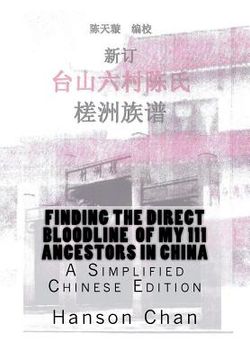Reseña del libro "Finding the Direct Bloodline of My 111 Ancestors in China"
In addition to the Chinese text, there is a brief English summary of all the names and places of our 111 ancestors of the direct bloodline tracing from son to father, father to grandfather, and grandfather to great-grandfather, and so on until reaching the originator of the "Chan" family tree or genealogy that this writer has found through records of genealogy, public entries, and including history of ancient China. "Chan" in Chinese is a Romanized translation of its Cantonese pronunciation done in Hong Kong; it pronounced "Chin" in Tai-shan dialect, and "Chen" in Mandarin. So, nowadays, when we see "Chan" or "Chin or "Chen," it might be simply the same last name in Chinese, but sounds different. This book details the clan records of the Cha-chou Village of the Chan family in Liu-cun, Taishan, Guang-dong, China. Chen You, the originator of the clan was a resident of Nan-xiong before he moved to Xin-hui, then his offspring continued their migration to Taishan; first relocated to Shang-ge, again to Lang-mei that became the center of Liu-cun. By 1703, Chen Yu-fu settled at Cha-chou Village. Chen Yu-fu (1657-1727), who lived during the early part of the Qing Dynasty, was a renowned scholar of Confucianism, and he wrote and published books which were reprinted even in the present days. According to the record, Chen Yu-fu became a "Jie-yuan" in his civil examination in Guang-dong Province in 1690; and, surprisingly, his son Chen Han also became a "Jie-yuan" in 1714. What was more, his great-grandson Chen Si-guan earned the title of "Jin-si" in 1803 and was praised as the only person who had held such a honor within the Ming and Qing dynasties in the Taishan County. Interestingly, the Taishanese were the earliest group of Chinese labors who came to the United States as railway workers on contracts. Then, many of them settled down afterwards and their offspring were American-born who helped the development of many Chinatowns in major cities in USA and Canada. If you were one of those Taishanese descendants and lost track of your ancestors, or maybe just the partner, or a friend of such a well-known bloodline of the Chinese Pioneers, here is a chance that you might find the roots and names in the Chan's (or Chen's) various branches in this journal of genealogy among the pages.

